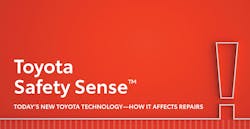Toyota Safety Sense™ (TSS)1 is a suite of active safety technologies and driver assistance systems that help address three areas of accident protection:
- Preventing or mitigating frontal collisions
- Keeping drivers within their lanes
- Enhancing road safety during nighttime driving
You need to be aware of these systems, how they operate and where the sensors are located in case a Toyota vehicle with TSS comes into your collision repair facility. To understand what these safety systems are intended for, and to confirm that they are functioning as intended, refer to the New Car Features (NCF) manual on Toyota’s Technical Information System website: https://techinfo.toyota.com/.
- To access the NCF, enter the model and year, then click on NCF.
- Once on TIS, you can also click on the Repair Manual (RM) tab or the Collision Damage Repair Manual tab (CR) to locate procedures for measuring mounting locations, performing initializations, calibrations and operational checks.
- It’s important to perform pre- and post-repair health checks, and to complete calibration functions necessary for Safety Sense systems.
- Follow the RM and CR procedures to complete initializations, calibrations and operational checks of systems and components related to TSS.
Most Common TSS Features
Pre-Collision System (PCS) with Vehicle and Pedestrian Detection2 Uses a forward recognition camera and a grille-mounted millimeter wave radar sensor or laser to reduce the likelihood of colliding with a preceding car, pedestrian or bicyclist (for TSS 2.0 and newer systems).
Dynamic Radar Cruise Control (DRCC)3 The system uses the same camera and radar as PCS to detect vehicles in front of you, and to automatically adjust vehicle speed to maintain a pre-set distance behind the vehicle ahead. It also provides the ability to automatically adjust speed to maintain the flow of traffic.
Lane Departure Alert (LDA)4 Lane Departure Alert (LDA)4 uses the forward recognition camera to detect the vehicle’s position in the lane and notifies the driver with an audible and visual alert when it detects unintended lane departure from its visibly marked lane. Select Toyota vehicles with Electronic Power Steering (EPS) also have Steering Assist, which may detect unintentional drifting and may automatically make small corrective steering inputs to help keep the vehicle in its lane.
Automatic High Beams (AHB)5 When activated, the forward recognition camera detects the headlights of oncoming vehicles and taillights of preceding vehicles, then automatically toggles between high and low beams to help drivers see more clearly at night while reducing glare for other drivers.
Road Sign Assist (RSA)6 On TSS 2.0 and newer systems, the vehicle’s forward recognition camera and navigation system have the ability to read certain traffic signs and display them on the vehicle’s multi-information display or via the Head-Up Display to enhance driver awareness of posted road signs.
Lane Tracing Assist (LTA) Works automatically when the Full-Speed Dynamic Radar Cruise Control (DRCC) is active and lane markers are visible. LTA uses the forward-facing camera to monitor the lane markers as well as the path of the vehicle, then automatically make steering inputs to help keep the vehicle centered in its lane and preemptively avoid unintended lane departures.
Repairing Vehicles with TSS
When repairing a vehicle with TSS, it’s critical to know which TSS components are installed on that vehicle, as they can vary year to year and by trim level. The easiest way is to log on to the Toyota Information System (TIS) https://techinfo.toyota.com/, enter the model and year and select ADAS (Advanced Driver Assistance System*) under Service Category. You’ll note that the ADAS category is a recent addition to TIS and is only available on newer models. If you are repairing an older model, you may have to conduct a more thorough search to find TSS component repair procedures. Please refer to the Applicability Chart for the proper names of the TSS systems.
Vehicles equipped with TSS mean that they come with an array of cameras and sensors that you need to be aware of, as many will require precise calibration. This includes:
- Front Camera with Camera Heater—The forward recognition camera is located inside the vehicle at the top center of the windshield in front of the rearview mirror. It’s a key element in most of the TSS systems and the camera lens should never be touched. If it’s touched, it should be replaced. Or, if the camera is struck, dropped or has any foreign matter on it, it must also be replaced. Finally, if the camera bracket is damaged, it, too must be replaced along with the windshield.
- Millimeter Wave Radar System—is a vital part of TSS and is attached to the backside of the front Toyota emblem in the grille.
Calibration for these sensors is required when certain procedures take place, and those procedures can vary by model year and trim level, which is why you need to research each model before you begin repairs. Sensors need to be calibrated if they have been affected by a collision, or by removal or replacement. For example, that means any time a vehicle has had a bumper cover or grille removed and reinstalled or replaced, or needs a wheel alignment, the sensors need to be calibrated.
Proper repair and painting procedures around each sensor are vital, because if one or more of the sensors becomes inoperable, TSS may not function as intended. That’s why you must make sure the sensors and cameras are properly calibrated after repairs are complete. In addition, you should also conduct a post repair/calibration test drive to confirm all systems are operating as intended.
Follow the repair procedures based on the TSS System that is on the vehicle you’re working with. This ensures you return a vehicle that functions as new and maintains Toyota safety standards.
About the Author
Sponsored Content
The views and opinions expressed in this piece do not necessarily reflect those of 10 Missions Media and its associated brands.
